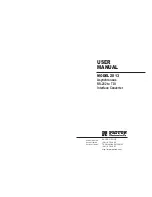
3
AC Input/Output Wiring Instructions
NOTE: The CEPS-A can be field-wired in 3 distinct modes of operation. See “WIRING MODES” i n s e r t
sheet for further details.
#1) (FACTORY DEFAULT) NORMALLY-ON: The emergency lights connected to the CEPS-A will be ON at all
times, during both normal condition and power interruptions. This mode is set by connecting the #1 wire on the
red transfer switch to the utility input hot.
#2) NORMALLY-OFF: The emergency lights connected to the CEPS-A will be OFF until a power interruption, at
which time they will turn ON. This mode is set by capping off the #1 wire on the red transfer switch.
#3) NORMALLY-SWITCHED: The emergency lights connected to the CEPS-A can be switched ON/OFF
normally, until a power interruption, at which time they will turn ON regardless of switch position. This mode is
set by connecting the load side of a switch, time clock, or relay panel to the #1 wire on the red transfer switch.
Please note: Only one switch can be used per inverter. If multiple switches are needed, wire inverter as
NORMALLY-ON, and use LVS EPC relays. With EPC relays an unlimited number of switch legs may be used.
Contact tech support for further details 1-800-982-4587.
The CEPS must be installed by a qualified electrician in accordance with local, state, and NEC codes. AC & DC
Voltages are hazardous and care should be taken to follow all instructions. Prior to wiring AC connections, discon-
nect AC Input feed at relevant branch circuit breaker(s) and verify using proper voltage meter.
Always wear appropriate clothing when handling batteries and equipment, and use insulated tools.
1) Check that all input breakers are disconnected. Trip all output breakers using a flat screwdriver.
2) Check that knockouts on top of panel have been removed and conduits have been installed.
3) Bring AC Input conductors and AC Output Conductors through the appropriate conduits. Per
NEC, emergency output circuit should be installed in a dedicated conduit.
4) Connect AC Input conductors to wires labelled “120VAC Input” or “277VAC Input”
5) Connect AC Output conductors to wires labelled “120VAC Output” or “277VAC Output”
(277V MODELS 1000W & Larger ONLY): Take ACME XFR out of box and mount per instructions. Confirm
that it has been properly configured: X1 should be connected with X3. X2 should be connected with X4.
Connect one of XFR A wires in panel to X1&X3 in transformer (also labeled XFR A).
Connect other XFR A wire in panel to X2&X4 in transformer (also labeled XFR A).
Connect one XFR B wire in panel to H1 wire in transformer (also labeled XFR B).
Connect other XFR B wire in panel to H5 wire in transformer (also labeled XFR B).
NOTE: For 277V systems 1000W & Larger ONLY, the XFR B wire in the transformer which is connected to
the White with Blue Stripe (#4) XFR B wire in panel should be grounded, because it is the neutral output of an
isolation transformer. See transformer grounding instruction sheet provided.
6) Connect grounds for AC Input & AC Output to grounding wires provided.
For systems larger than
1000W, NEC requires a grounding electrode conductor be installed from panel to grounding electrode.
7) Refer to battery wiring instructions.
8) Ensure that cabinet is securely fastened to wall and that no wires are loose or disconnected.
9) Ensure all connections & grounding have been made in workman-like & code compliant manner.


























